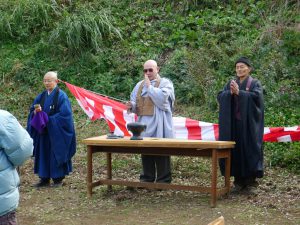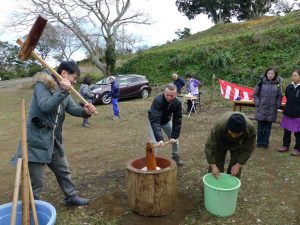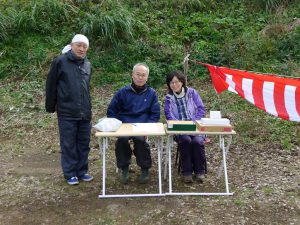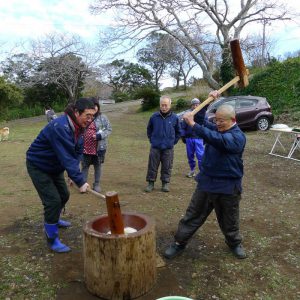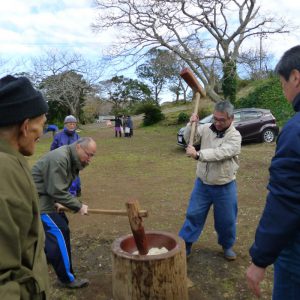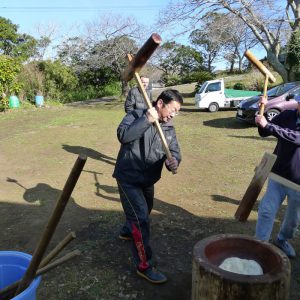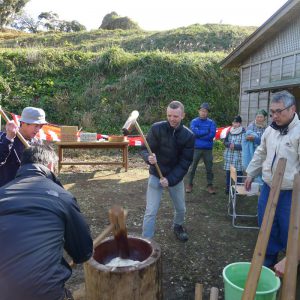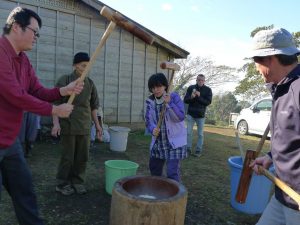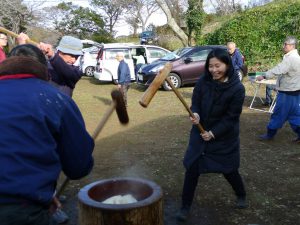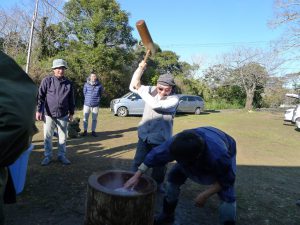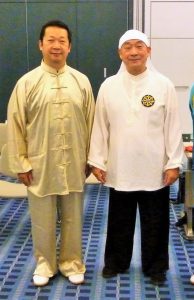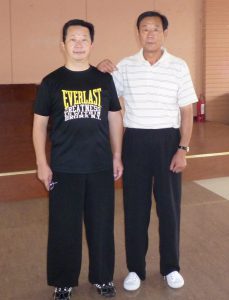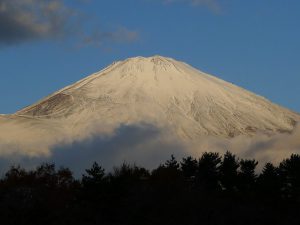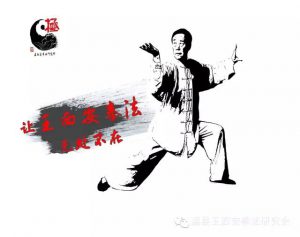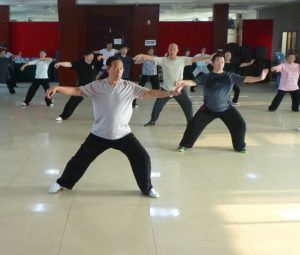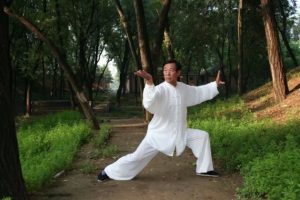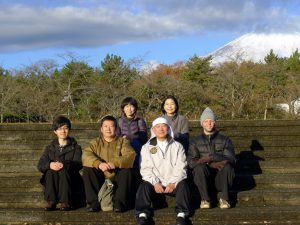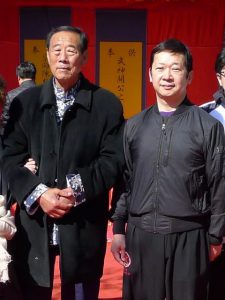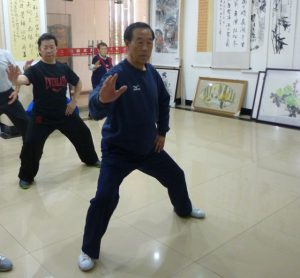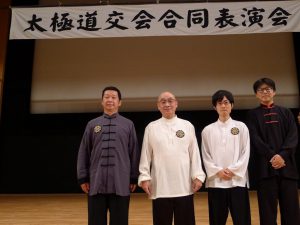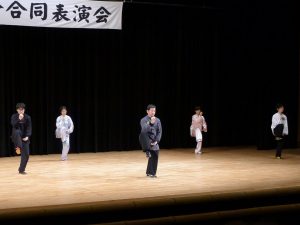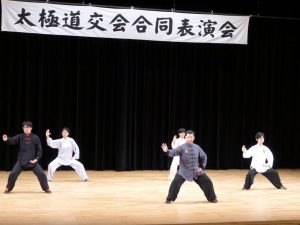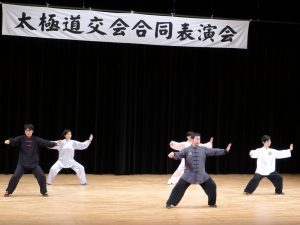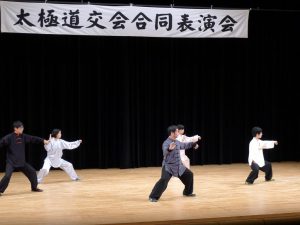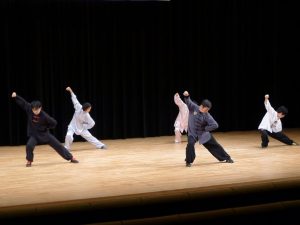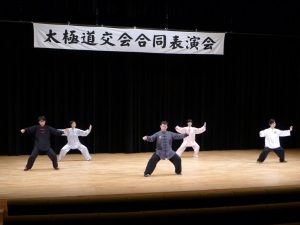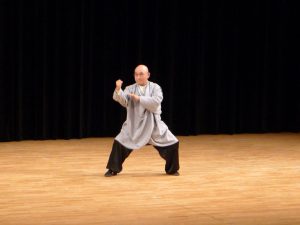A World Where Everything Will Be Alright Whichever Way Things Fall: The Foundations of Zen and Taijiquan
English translator Andrew Carrico ( Edogawa Branch )
*The following was aired on May 25, 2018 on NHK Radio 2’s Shukyo no Jikan.
Narrator: Welcome to the program. Today’s guest is Hakuei Yamaguchi, abbot of Nonin-ji Temple in Tateyama, Chiba Prefecture and head of Taikyoku Dokokai. He will be speaking on the foundations of Zen and taijiquan (tai chi).
Mr. Yamaguchi was born in 1947 in Osaka City. At 19 he became a monk at Keiden-ji Temple of the Soto school in Nara. He continued his training in Rinzai and Soto Zen at Enkaku-ji Temple in Kamakura and Bukkoku-ji Temple in Fukui Prefecture among other places. Mr. Yamaguchi started learning taijiquan in 1973 when he was 26. Later, for more than 30 years starting in 1982 he took trips to China to learn Chen-style taijiquan, the oldest form of taijiquan, from the foremost masters. Mrs. Yamaguchi says that after his years of training in taijiquan he came in touch with the place where the paths of Zen and taijiquan converge. Today we will hear him speak about this place he has arrived at by following the paths of Zen and taijiquan. The interviewer is Atsushi Hirai.
Hirai: We’ve used the title “A World Where Everything Will Be Alright Whichever Way Things Fall” for this episode. I’ve heard that this is a phrase that’s been important to you since you were very young. What do these words mean to you?
Yamaguchi: I was born soon after the War. Japan was in a very difficult situation during this period. I saw wounded soldiers and people living on the streets. The occupying forces came with their brazen attitude towards Japanese people. Worst of all there was nothing to eat in these times. When I was in elementary school the first thing I would do after coming home was check the rice bin to see if there was any rice. If I found rice I could play happily, but if not I would worry about what we would eat that night.
One thing I began to wonder during this period of post-war turmoil was whether there is a place in which, no matter which way things fall, everything would be alright. The world operates on conditions. If I have money I’m okay, if not then I have a problem. As I grew older I started to seek out the place where such conditions were not required for security, where I could be content either with or without. I didn’t know what kind of place that would be, but I wanted to know. And my desire to know continued to develop.
When I was around 13, 14 or 15, I instinctively felt there must be a spiritual world out there far beyond the capabilities of human beings. So one night I woke up and took a correspondence course on Christianity. I became a Christian for half a year as I wanted to know God. The feelings I’ve had since I was very young weren’t resolved at that time but the feelings were becoming consolidated as I matured and they started to determine a direction for me.
Hirai: And so eventually you became a monk. How did that happen?
Yamaguchi: I found an introductory book about Zen at a book store and for some reason I got the sense that all the answers to the questions I had been carrying with me were written in this book. When I was about 16 I felt that the true way of living for me was contained in Zen.
Hirai: And this concerns the world where everything will be okay whichever way things fall?
Yamaguchi: Yes. It turns out that this world is inside of me. It’s nowhere but here. It’s the place where I can stay unaffected by other things. When I encountered the Buddha’s words, “I am the one and only,” I felt like my life had been determined.
Hirai: So you went to the Zen temple in Nara Prefecture with such goals.
Yamaguchi: Yes.
Hirai: How was your experience training there?
Yamaguchi: Well, at first there was more time set aside for work than for zazen. I remember having to perform chores from morning to night. My teacher was an extremely strict person. After I finished sweeping the garden he would come out and sway the trees so that leaves would fall on the ground again. Then he would say “You see what’s down below but not what’s above!” and walk away. The same thing would happen when I was wiping the floor. He would point out spots I missed and tell me how to do it properly. But it made sense. “Sweep so that the tip of the broom will wear out flat!” “Don’t sweep in a way that will make the broom arched!” I was thoroughly gruelled while performing the daily chores.
Hirai: Did all this chores have a purpose?
Yamaguchi: Yes, it did. My teacher had a saying to the effect of ‘apply yourself diligently to that which is meritless.’ Don’t seek results. Don’t be troubled with success and failure. Just do what you are doing utterly. That’s what it meant.
About a week after entering the temple I went to my teacher and asked him, “What is world peace?” He said, “First learn the sutras.” Then I asked, “How can world peace be achieved?” He said, “Go in your room!” so I did. Then he told me, “The powerless bodhisattva drowns in his attempt to save others. So you must develop your power.” He taught me that developing power means learning to act fully in every moment and that this can be achieved through practice. I believe it was an education in devoting one’s whole body and mind to the situation at hand.
Hirai: Did you train there for some time?
Yamaguchi: Yes, I trained for three years. During that time a monk visited the temple who would later be my zazen teacher. His name was Tosui Ota and he visited the temple as a travelling monk. He had previously spent 30 years in a mountain just practicing zazen and I greatly admired him for that. After listening to him speak at length, his final words to me were, “Your eyes gleam when you are listening to the Dharma. Faithful one, if you are to become a true monk go into the fields!”
Hirai: He said that to you?
Yamaguchi: Yes, to me.
Hirai: He said that your eyes were gleaming?
Yamaguchi: Yes, that my eyes were gleaming when listening to the Dharma. He used a word referring to one who has the resolve to follow the true path. That’s how he saw me, and he told me to go into the fields if I was to become a true monk. At the time I was a monk in a temple and so I took those words to mean that I should focus on training myself. Eventually I left the temple in Nara and dedicated myself to zazen.
Hirai: You were committing yourself to the way of Zen. But in your mid-20s instead of limiting yourself to Zen you started practicing taijiquan.
Yamaguchi: Yes.
Hirai: How did this happen?
Yamaguchi: First, when I was eight I saw a newsreel about China at a movie theater called Sakurai Gekijo. That’s where I saw taijiquan. An old man came out of a room and plodded along a ridge between some rice fields. After he arrived at an open space his spine became erect somehow. When I saw him start to slowly move his body I was deeply moved. It left a mark on me. It made me feel like I wanted to join in.
Hirai: But at the time you didn’t know about taijiquan.
Yamaguchi: I hadn’t even heard the name ‘taijiquan.’ But similar to how I would later be drawn to zazen I caught a glimpse of something powerful, a steadfastness that humans can embody and its dignity and majesty.
Hirai: And that resonated with you at eight years old.
Yamaguchi: Yes. It would be almost 20 years before I would come into contact with taijiquan again. While I was a monk at Bukkoku-ji Temple (Fukui Prefecture) there was a Canadian who had come to practice zazen. This person had actually practiced quite a bit of taijiquan in Canada. It made me really want to practice too and so I practiced with him for about two years. These were happy days for me since I had such a strong desire to do taijiquan.
Hirai: What was your impression of taijiquan after practicing it a bit?
Yamaguchi: Well, it didn’t conflict at all with zazen. The slow movements are performed with deep breathing. Zazen is also done with deep breathing and with concentration. Both are about fully committing to the here and now with concentration, so there was nothing unnatural about it. It only gave me a greater desire to develop my practice further.
Hirai: I believe you were 28 when you first travelled to Taiwan to delve deeper into taijiquan.
Yamaguchi: That’s right. I actually wanted to go to China but it hadn’t been opened to foreigners yet so I was unable to go. That’s why I went to Taiwan first. I travelled back and forth for about five years but during that time I heard that mainland China has started to open their borders so I decided to travel to the continent. I must have been around 32 or 33 when I first went. I continued to go every year for nearly 30 years.
Since I would be going to China to learn taijiquan I wanted to go to its place of origin. Taijiquan originated in Chen Village where it continues to be practiced. It’s about a three-hour drive from Zhengzhou in Henan Province. My first teachers were Chen Xiaowang, 19th generation of the Chen family, and Wang Xian. In Japan this might be the equivalent of learning from Yagyu Jube from Yagyu Village. Both of these teachers were remarkable and it was a great privilege to be able to learn from them.
Later there was a blank period when both teachers were travelling abroad to places like Australia so I went to see a taijiquan master in Beijing who I had previously heard about. He was Feng Zhiqiang, of the 18th generation, and he was in fact a teacher of both Chen Xiaowang and Wang Xian. He had developed taijiquan through seven phases of evolution. His evolved form of taijiquan seemed to me to have a deeply Zen-like quality. It exhibited a development from technique to principle or from surface strength to inner strength. I felt that I must learn his taijiquan so I made trips to visit him over a 10-year period or so.
Hirai: So what is taijiquan exactly? How do you move your body and what is being performed? I’m sure it’s not easy to describe it in words.
Yamaguchi: We can look at the meaning of “taiji” in taijiquan. There is a negative pole and a positive pole, just like a battery. The negative we call yin and the positive we call yang. If we use the mathematical formula ‘–5 + 5 = 0,’ taiji is the point at which we arrive at zero.
Hirai: So it’s –5 and +5?
Yamaguchi: It could be 5 or 100 or 1,000. When we practice taijiquan we start with an unbalanced state of ‘–1 and +9.’ Then we move to ‘–2 and +8,’ ‘–3 and +7,’ ‘–4 and +6’ and finally ‘–5 and +5.’ That would be the completion, the ultimate. This refers to the balance of force. When the right hand goes up, the left hand goes down. When the right hand moves to the right, the left hand moves to the left. When the two opposing and mutually attracting forces balance out to ‘–5 and +5’ the practitioner’s movement has reached completion.
What normally happens is that when we hear ‘right’ all our attention goes to the right side and we’re unaware of the left. We start from an unbalanced state like this. In the unity at zero the yin and the yang disappear. And yet it’s the yin and yang that create that unity of zero. In Buddhism it is said that ‘form is emptiness and emptiness is form.’ Form is the material phenomenon of ‘–5’ and ‘+5.’ Emptiness is the unity of ‘= 0.’ So this system of dynamics is consistent with the Buddhist teaching of ‘form is emptiness and emptiness is form.’ In practicing taijiquan one must train through the five stages I mentioned.
The fundamental force for taijiquan comes from gravity. The force that pulls down generates the upward rising force. In the case of jumping, everything is allowed to drop right before the body leaps up.
Hirai: Universal gravitation is a force that is operating on human bodies all the time.
Yamaguchi: Exactly.
Hirai: So the muscles are used as well while using the force of gravity?
Yamaguchi: The idea is to eliminate most muscular force. It’s not that muscles aren’t used. The act of standing requires leg muscles. But we don’t rely on muscular force.
Hirai: So the body is moved using gravitational force?
Yamaguchi: Yes. There are these terms ‘primordial qi’ and ‘acquired qi.’ With acquired qi, one moves by way of muscular strength amassed after one is born. With primordial qi, one moves using only gravity. Primordial qi is qi that exists before birth. A practitioner would be around the third level when they start being able to use primordial qi. It isn’t possible yet in the first and second levels. In the first level one must learn the form. Each of the postures in taijiquan have names. And so in the beginning we learn routines called 83-form or 74-form containing postures such as ‘Buddha’s Warrior Attendant Pounds Mortar,’ ‘Lazily Tying Coat,’ ‘Single Whip’ and ‘White Crane Spreads Wings.’
Hirai: Many shapes with names.
Yamaguchi: Names of shapes. So it’s possible to pause in the postures. The practitioner becomes proficient in the forms to a degree and starts to emphasize the flow. This is the process of transitioning from shape to qi. What it required in this transition is movement using gravity.
Hirai: So instead of moving forcefully with your muscles you move in accordance with nature.
Yamaguchi: Yes. One parallel between zazen and taijiquan is the three elements specified in training the human organism: body, breath and mind. The body is adjusted, the breath is adjusted and the mind is adjusted. But there is one important point. Ultimately these three must become one through diligent practice and proficiency. When the three become one there is no longer name or form. That is to say, all that remains is flow – a flow with deep breaths in which body and mind are aligned.
The mind decides what to do. It directs the flow to the upper right, lower left, front, back, in all directions as it wills. This is the movement of taijiquan. When one enters the third of the five stages it becomes possible to proceed from form to formlessness. From formlessness one then proceeds to xinji, which can be translated as ‘vital secret of the mind.’ It reminds me of the words of Einstein. He said that there is a deeply hidden secret behind the world of objects and that truth is beautiful in its simplicity. The vital secret of the mind is in this same place. When one enters the body and then goes into the realm of the mind, the vital secret is experienced as unity of mind. In Zen this is called non-differentiated knowledge. It’s knowledge that’s beyond conceptualization.
Hirai: So it’s possible to enter such places in the mind by investigating bodily movements in taijiquan?
Yamaguchi: That’s right. It leads to the mind. Thich Nhat Hanh described this same process very simply. He said in practicing concentration you start with observation but then you gradually move to participation. He taught mindfulness.
Hirai: The word mindfulness is used frequently. Buddha spoke of it also and it started from there…
Yamaguchi: Yes. So there is observation and participation. The Zen master Dogen also spoke of this. In Zen we practice concentration. In the practice of concentration, ‘observation’ corresponds to practicing with total determination while ‘participation’ corresponds to practicing with such determination that the practice is forgotten. There is no longer awareness of determination. Once at this place of forgetting one can experience inspiration. This is called living in the secret of mind. There’s no longer any differentiation, just knowing.
Hirai: What they are saying in Zen…
Yamaguchi: It’s the same as ‘seeing in the secret of mind’ in taijiquan. I came to understand this point through my last teacher, Feng Zhiqiang, who taught the unification of heaven, earth and man. The three are brought together as one. Once I understood this I also understood that it’s the same in zazen. This is really the first realization. When heaven and earth are truly connected, you enter a place where there can’t be anymore differentiation. Differentiation is where up is not down and down is not up. However when up and down are connected by one single pillar the two can no longer be separated. It’s a posture where separation is not possible.
As for the mind, it enters the place of knowing without differentiation. I found that it’s the same with zazen after going back and researching once more. The mechanics can be described as the sinking of qi down to the dantian or abdomen. There is the sense of the belly becoming full as one breaths out and the back of the neck naturally becomes erect.
Hirai: You’ve been speaking about what you’ve felt in your body, not about reasoning or concepts, not matters of discussion. If I may ask again, how does the body move in taijiquan and what are the results?
Yamaguchi: In taijiquan there is the principle of entering the state of taiji at the end of each movement. For example if there are 74 forms you would enter that state 74 times. What happens is that you breathe out. Then you relax the qi down to the dandian at the center of the body. Relaxing the qi downwards means you let your shoulders, elbows and chest fall with the gravitational pull. Then the neck will stand up straight. The technical terms for this are xu ling ding jin (straighten neck and suspend head) and qi chen dan tian (sink qi to dantian).
Hirai: These moments arise during the performance of the taijiquan movements?
Yamaguchi: Yes, they do. I used to think that taijiquan was a means and that the goal was satori, enlightenment. But that wasn’t the case. The state emerges in the midst of practice. This is what Dogen taught as the ‘oneness of practice and attainment.’ It’s during the discipline of practice that enlightenment arises. So taijiquan is not a means. Nor is zazen.
Hirai: It arises in the movements.
Yamaguchi: It’s a field that emerges, you could say. The ‘union of heaven, earth and man’ refers to this state of being.
Hirai: It arises during taijiquan…
Yamaguchi: A force that pulls upwards as well.
Hirai: Does the same thing happen while you are practicing zazen?
Yamaguchi: It’s the same mechanics. I was able to learn it through taijiquan.
Hirai: Since you were young you were seeking the world where everything would be alright whichever way things fell.
Yamaguchi: And this was the answer. What it means is that it’s okay to be at heaven, okay to be at earth, okay to be in front or to the back, to the right or to the left. Everything connected for me. The true answer is that there is no falling. The world where everything will be alright is the world in which there is no falling to begin with because everything has become connected. This is world then transforms into ecstatic joy with the power of knowing. The person who knows that everything will be okay no matter what can smile genuinely. The heart experiences joy, peace, freedom and peace that all people are seeking. It doesn’t matter what happens in the outside world.
Hirai: It’s an experience that’s far from reach for somebody like me who hasn’t trained seriously. And yet I feel as if I’ve had a glimpse of the truth.
Yamaguchi: That’s what I was looking for when I first became a monk. It’s something that’s inside of you, first of all. Then, when heaven and earth are connected, the separation between the self and everything else starts to disappear. You become deeply moved by the fact of existence. This is why I feel that it is my mission to pass on taijiquan as a ‘moving Zen’ to future generations.
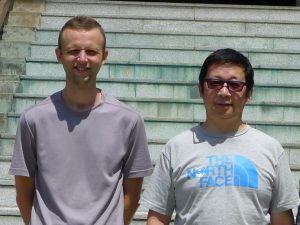
Andrew
Houen Miura
